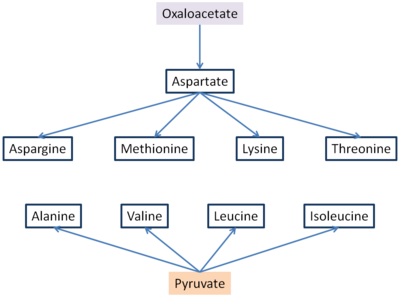Hasse norm theorem
Template:Chembox Oxaloacetic acid (also known as oxalacetic acid) is a crystalline organic compound with the chemical formula HO2CC(O)CH2CO2H. Oxaloacetic acid, in the form of its conjugate base oxaloacetate, is a metabolic intermediate in many processes that occur in animals. It takes part in the: gluconeogenesis, urea cycle, glyoxylate cycle, amino acid synthesis, fatty acid synthesis and citric acid cycle.[1]
Properties
Oxaloacetic acid undergoes successive deprotonations to give the dianion:
At high pH, the enolizable proton is ionized:
The enol forms of oxaloacetic acid are particularly stable, so much so that the two tautomer have different melting points (152 °C for the cis isoform and 184 °C for the trans isoform).
Biosynthesis
Oxaloacetate forms in several ways in nature. A principal route is upon oxidation of L-malate, catalysed by malate dehydrogenase. It arises from the condensation of pyruvate with carbonic acid, driven by the hydrolysis of ATP:
- CH3C(O)CO2- + HCO3- + ATP → -O2CCH2C(O)CO2- + ADP + Pi
Occurring in the mesophyll of plants, this process proceeds via phosphoenolpyruvate, catalysed by pyruvate carboxylase. Oxaloacetate also arises from degradation of aspartic acid.
Biochemical functions
Oxaloacetate is an intermediate of the citric acid cycle, where it reacts with Acetyl-CoA to form citrate, catalysed by citrate synthase. It is also involved in gluconeogenesis, urea cycle, glyoxylate cycle, amino acid synthesis, and fatty acid synthesis. Oxaloacetate is also a potent inhibitor of Complex II.
Gluconeogenesis
Gluconeogenesis[1] is a metabolic pathway consisting of a series of eleven enzyme-catalyzed reactions. It results in the generation of glucose from non-carbohydrates substrates. The beginning of this process takes place in the mitochondrial’s matrix, where pyruvate molecules are found. A pyruvate molecule suffers a carboxylation by the intervention of pyruvate carboxylase enzyme, activated by a molecule each of ATP and water. This reaction results in the formation of oxaloacetate. NADH reduces oxaloacetate to malate. This transformation is needed to transport the molecule out of the mitochondria. Once in the cytosol, malate is oxidized to oxaloacetate again using NAD+. Then oxaloacetate remains in the cytosol, where the rest of reactions will take place. Oxaloacetate is later decarboxylased and phosphorylated by the phosphoenolpyruvate carboxykinase and it becomes 2- phosphoeneolpyruvate using a GTP as phosphate source. After this processes have occurred, some other chemical reactions take place (where oxaloacetate does not appear) until glucose is obtained.
Urea cycle
The urea cycle is a metabolic pathway that results in the formation of urea using two ammonium molecules and one bicarbonate molecule.[1] This route commonly occurs in the hepatic cell of the liver. (The reactions related to the urea cycle produce NADH). This NADH can be produced in two different ways. One of these uses oxaloacetate. In the cytosol there are fumarate molecules. Fumarate can be transformed into malate by the actions of the enzyme fumarase. The malate suffers the actions of malate dehydrogenase enzyme and it becomes oxaloacetate and producing a molecule of NADH. After that, oxaloacetate will be recycled to aspartate, as transaminases prefer these keto acids over the others. This recycling maintains the flow of nitrogen into the cell.

Glyoxylate cycle
The glyoxylate cycle is a variant of the citric acid cycle.[2] It is an anabolic pathway occurring in plants and bacteria utilizing the enzymes; isocitrate lyase and malate synthase. Some intermediate steps of the cycle are slightly different from the citric acid cycle; nevertheless oxaloacetate has the same function in both processes.[1] This means that oxaloacetate in this cycle also acts as the primary reactant and final product. In fact the oxaloacetate is a net product of the glyoxilate cycle because its loop of the cycle incorporates two molecules of acetyl-CoA.
Fatty acid synthesis
In previous stages acetyl-CoA is transferred from the mitochondria to the cytoplasm where fatty acid synthase resides. The acetyl-CoA is transported as a citrate, which has been previously formed in the mitochondrial matrix from acetyl-coA and oxaloacetate. This reaction usually innitiates the citric acid cycle, but when there is no need of energy it is transported to the cytoplasm where it is broken down to cytoplamatic acetyl -CoA and oxaloacetate.
Another part of the cycle requires NADPH for the synthesis of fatty acids.[3] Part of this reducting power is generated when the cytosolic oxaloacetate is returned to the mitochondria as long as the internal mitochondrial layer is non-permeable for oxaloacetate. Firstly the oxaloacetate is reduced to malate using NADH. Then the malate is decarbolxylated to pyruvate. Now this pyruvate can easily enter the mitochondria, where it is carboxilated again to oxaloacetate by pyruvate carboxylase. In this way, the transfer of acetyl-coa that is from the mitochondria to the outside of the cell into the cytoplasm produces a molecule of NADH. The overall reaction, which is spontaneous, may be summarized as:
- HCO3- + ATP + acetyl-CoA → ADP + Pi + malonyl-CoA
Amino acid synthesis
Six essential amino acids and three nonessential are synthesized from oxaloacetate and pyruvate.[4] Aspartate and alanine are formed from oxaloacetate and pyruvate, respectively, by transamination from glutamate. Asparagine, methionine, lysine and threonine are synthesized by aspartate, therefore given importance to oxaloacetate as without it, no aspartate would be formed and the following other amino acids would neither be produced.

Oxalate biosynthesis
Oxaloacetate produces oxalate by hydrolysis.[5]
This process is catalyzed by the enzyme oxaloacetase.
Interactive pathway map
| Template:GlycolysisGluconeogenesis WP534 | Template:TCACycle WP78 |
See also
References
43 year old Petroleum Engineer Harry from Deep River, usually spends time with hobbies and interests like renting movies, property developers in singapore new condominium and vehicle racing. Constantly enjoys going to destinations like Camino Real de Tierra Adentro.
Template:Citric acid cycle Template:Amino acid metabolism intermediates
- ↑ 1.0 1.1 1.2 1.3 Template:Lehninger4th
- ↑ http://www.pearsonhighered.com/mathews/ch14/c14gc.htm
- ↑ Template:Cite web
- ↑ Template:Cite web
- ↑ Gadd, Geoffrey M. "Fungal production of citric and oxalic acid: importance in metal speciation, physiology and biogeochemical processes" Advances in Microbial Physiology (1999), 41, 47-92.